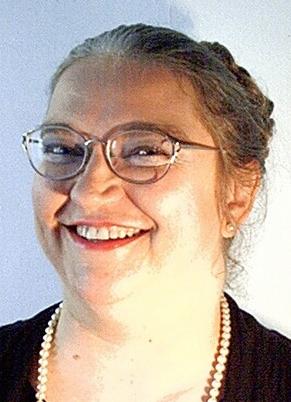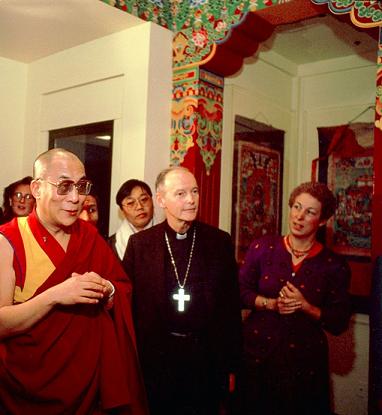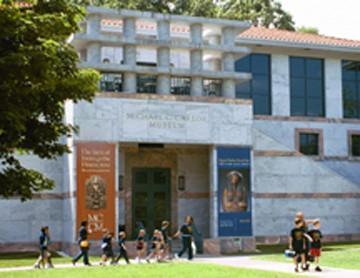| Temples of Culture: Using Museums for Site Visits |
![PDF-NOTE: Internet Explorer Users, right click the PDF Icon and choose [save target as] if you are experiencing problems with clicking.](http://rsnonline.org/templates/rsntemplate-smallmasthead/images/pdf_button.png) |
 |
Lisa Bellan-Boyer, Hudson County Community College
Visitor surveys frequently reveal that people regard museums as something like a church. When asked if a museum is like a list of other institutions (church/temple, school, university, department store, library, etc.) more people answer “church” than any other choice. This is a particularly interesting phenomenon for the joint fields of religious studies and museum studies. Though frequently underutilized, museums are an excellent resource for religious studies pedagogy. They steward dazzling and exciting collections, have their own educational mission, and provide a secular “safety zone” for learning about religious traditions that might otherwise be inaccessible, for geographic or ideological reasons, to many students. They are also able to offer a framing, historical perspective that is unlikely to be as fully developed in an active religious site, with perhaps some notable exceptions. Some religious institutions are also museums, such as the California Spanish missions, which are chapels as well as National Park sites. For example, the three-century-old Trinity/St. Paul’s Episcopal parish in Lower Manhattan has been a place where history, religion, and civic life have interacted since the time of George Washington. It received renewed significance as a civic and religious landmark after surviving the World Trade Center collapse, when it served as a respite center for workers at the site. Virtually every museum of any size has an education and public programs department. In the ’80s, this became a growth area for museum development — grants could be obtained for education departments when they were not available for other museum programs and conservation agendas. Consequently, larger museums offer off-site as well as on-site programs, such as Internet resources, in-class teaching aids, curriculum support kits, museum staff that travel for classroom presentations and workshops, and, as in the case of the Newark Museum, a collection of objects and artifacts of museum quality available for institutional loan — enough offerings to thoroughly debunk the false notion that if the school cannot afford field trips, then museums are not useful to them. Every school, college, and university, no matter how remotely located, can make use of museum Web sites and off-line resources of museum education departments all over the world. They should not neglect to utilize these vast free or low-cost resources. Local schools and public libraries can help play a vital role in this partnership. Incorporating the riches of the art world into curriculum planning is not so much a matter of creating new systems as it is of more intelligent and strategic use of resources that are waiting to be utilized. Nearly every city and town has museums, historic sites, and/or National and State Park systems in their region. In these settings, religious studies classes can find experiential introductions to the effect of religious ideas on architecture and of visual culture on societies in different historical periods and cultural contexts.
Having seen Chola-period bronzes of Shiva from a museum, students are more apt to notice miniature versions in store windows, restaurant niches, or at the local mandir (temple) on a site visit. Museums can often teach and interpret symbolism with a wider and more comparative perspective than that which is given by interpreters from a single-faith community on a single site visit. When students experience more than one kind of explanation for a symbol or an artifact, it helps them understand that symbols evolve with shifting historical, political, and cultural contexts. Students often get excited about reading about a subject after they see, hear, smell, and feel a place that relates to that subject. Drawing on recent examples from a “Religions of the West” course I taught this past spring, after visiting New York’s Museum of Jewish Heritage, students made statements such as “It seemed as if ‘the Jewish Tradition’ section of our textbook had come to life.” An African-American male from an urban working-class background wrote in his site visit report, “My time there became more than a detached academic viewing and became more of a human experience.” Perhaps one of the most important resources the museum offers to religious studies is a safe space for dialogue — providing representations of the sacred in spaces that are framed as secular. This is a challenge for museum exhibit designers, planners, and educators, in that they must simultaneously present the topic with integrity for believers, neutrality for nonbelievers, and breathing space for that lively population of people who say they are “spiritual but not religious.” In 2001 and 2002, the Newark Museum’s African Art Galleries featured the temporary exhibit “Faces of Worship: A Yoruba God in Two Worlds.” This exhibit displayed altars to the orisha (deity) Shango, in Yoruba traditions of Nigeria, Brazil, Trinidad, and modern-day New Jersey/New York. The opening reception included John Mason, a Yoruba diviner and priest of Obatala, offering prayers and pouring a libation to honor the ancestors. The exhibits were authentic enough that devotees felt it appropriate to pray and leave money offerings at the altars. At the same time, Evangelical Christians were able to observe and learn from the exhibits with much less opprobrium than they likely could have if taken to a Yoruba ceremony outside the secularized “border zone” of the museum walls. Further, the museum’s historical focus on the African diaspora provided a perspective on Shango not likely to be as fully developed in any single practicing community. Contextualized history contributed to creating a “safe space” to learn about Yoruba practices for students outside the traditions.
While museums are frequently experienced by students as “safer” than houses of worship, they also can be frightening and traumatic. Several students in the class reported that the exhibit floor of the Museum of Jewish Heritage focusing on the Nazi period made them feel that they were in a haunted space. After visiting the Metropolitan Museum of Art, one student, an immigrant from Ecuador, thanked me because he had only ever been to one museum in his life: Madame Tussaud’s Wax Museum. He had been quite worried about going into another museum, since that first experience had frightened him and given him nightmares. Religious studies teachers can perform a valuable reciprocal service to museums, introducing them to the uninitiated as an important and enriching part of civic and community life. Another student, a young woman of Cuban background, reacted negatively to the Cloisters, the Metropolitan Museum of Art’s landmark building. Located in Manhattan’s Fort Tryon Park, the Cloisters are constructed of European architectural elements dating from the 12th to the 15th centuries, and house gardens featuring period horticulture and the bulk of the Met’s collection of Medieval and Gothic art and artifacts. The student said, “It was like a ‘Chamber of Horrors’! — dark and dank, and all the artwork had blood in it.” When asked to talk more about her experience, she mentioned that she was there alone on a rainy, dreary day, which heightened this impression. Asked to identify something she liked, she mentioned that she thought the Unicorn Tapestries were beautiful, and wondered why the people in the tapestries wanted to kill the unicorn. This became an opportunity to discuss symbolism in allegories of Christ. She later went back to the Cloisters on a brighter, sunny day. Museums do have some shortcomings as alternate site visit options. Like textbooks, exhibition labels and brochures from a museum often must omit important information, due to practical constraints of accessibility for gallery visitors. Museum curators and educators who have expertise in their specializations can sometimes be deficient in their religious studies knowledge. They may make errors with regard to the diversity of denominational traditions and historical developments, or incorrectly use terms with rather precise religious definitions, such as “sect” or “sacrament.” Museum staff can be unaware of current understandings in religious studies about gender dynamics in religious history and culture. Even major museums are subject to these pitfalls. In the 1999 Gustav Moreau exhibit at the Metropolitan Museum of Art, a label next to one of his fabled paintings of Salome stated that “the New Testament describes Salome as a seductive femme fatale.” And although the museum field has done much to culturally diversify exhibit materials and programs, the legacy of colonialism can still be discerned in the halls of many an institution. I regularly ask my students to consider why there are Halls of Native American, African, and Asian Peoples at the American Museum of Natural History, complete with sacred objects and religious artifacts from those cultures, yet there is no Hall of European Peoples, treating them with the same ethnographic, anthropo- logical hand. Coordination of museum resources with educational opportunities and building collaborative networks between museum professionals and religious studies educators would be helpful to both fields, and to the evermore diverse public that they serve. Despite these pitfalls and drawbacks, visiting a museum exhibit offers the potential to bring out the fullness of human experience for students. The “shadow side” of cultural history can find a teachable focus, fostering empathy and critical questioning. At the same time, a people known by outsiders for being oppressed and persecuted can be seen in another light, in terms of ingenuity, humor, and resilience. After going through the Museum of Jewish Heritage, a student wrote, “Now I can understand and appreciate the traditions and celebrations as well as their major tragedies, and this is uplifting.” Students who are familiar with the history of their own people’s oppression may be jolted into an awareness that this has not been solely their own people’s lot. I revel in hearing the exclamatory question “Why didn’t they teach us any of this history in high school?” This is the power of empathy, in all its pain and glory, a quality of experience that introduces students into the wider human community. |


 Lisa Bellan-Boyer is an Adjunct Professor of Humanities and Religious Studies at Hudson County Community College, consultant for the Art Gallery at the American Bible Society and the Newark Museum, and a volunteer chaplain at the Office of the Chief Medical Examiner of New York.
Lisa Bellan-Boyer is an Adjunct Professor of Humanities and Religious Studies at Hudson County Community College, consultant for the Art Gallery at the American Bible Society and the Newark Museum, and a volunteer chaplain at the Office of the Chief Medical Examiner of New York. The resources of museums work best for religious studies courses when used to expand and augment student experiences with actual worshipping communities. They allow students to understand something about the visual culture and practice of faith traditions, giving them a wider set of tools for observing modern adaptations of tradition in active, contemporary communities. Viewing museum exhibits is an excellent way to prepare for a site visit to an actual house of worship.
The resources of museums work best for religious studies courses when used to expand and augment student experiences with actual worshipping communities. They allow students to understand something about the visual culture and practice of faith traditions, giving them a wider set of tools for observing modern adaptations of tradition in active, contemporary communities. Viewing museum exhibits is an excellent way to prepare for a site visit to an actual house of worship. Museums are often places where students feel free to ask questions about a religious practice they might feel inhibited asking in the presence of believing hosts at a religious site. This helps the task of encouraging student analysis and critical thinking. Some students who do not feel comfortable in the worship space of another religion can make the acquaintance of other traditions — and the ethics and traditions of tolerance — through a museum visit. From an ethnic Roman Catholic background that had shaped him to say that “the Jews killed Jesus,” one of my students chose to visit the Museum of Jewish Heritage, rather than visit a synagogue service, because he wanted to “avoid compromises with religion.” He reported after his visit that “anti-Semitism does not look very attractive after viewing the many relics and exhibits there.”
Museums are often places where students feel free to ask questions about a religious practice they might feel inhibited asking in the presence of believing hosts at a religious site. This helps the task of encouraging student analysis and critical thinking. Some students who do not feel comfortable in the worship space of another religion can make the acquaintance of other traditions — and the ethics and traditions of tolerance — through a museum visit. From an ethnic Roman Catholic background that had shaped him to say that “the Jews killed Jesus,” one of my students chose to visit the Museum of Jewish Heritage, rather than visit a synagogue service, because he wanted to “avoid compromises with religion.” He reported after his visit that “anti-Semitism does not look very attractive after viewing the many relics and exhibits there.”